Our MySupport App is a centralized communication platform for support workers that assist students in special education.
Check out our website here: MySupport Website
Our MySupport App is a centralized communication platform for support workers that assist students in special education.
Check out our website here: MySupport Website
Our MySupport App was very much one that was relevant to both Helena and I, as we have had previous experience working in the health and education sector such that we were able to see and understand the need for such a centralized platform.
Drawing from the approaches of data-mining and pedagogical documentation of “the living wall”, we hoped to center students’ in special education and their perspectives alongside data- driven methodologies such that we can have a more comprehensive approach to support their needs.
I believe both these quantitative and qualitative approaches can be seen as extensions of core concepts in Media Ecology and New Materialism, specifically the “intra-action and diffusion” of information between the “selbstbildung” of the individual student, surrounding support workers, and their environment, as well as the artifacts and progress they make in the learning process.
In terms of our design process, we were drawing from approaches in UI/UX design and research principles, though not as vigorous as we had hoped to, due to time constraints and limitations.
Moving forward, I believe having a stronger understanding of UX design processes will be helpful with finding more robust solutions to serve the needs of the different people this app was intended for, especially with such a broad range of professions we need to take into consideration.
I believe we have a strong conceptual idea very early on in the term, however, the execution and technical difficulties we ran into was what set us back in terms of time.
I think the biggest challenge was trying to find a suitable platform to host our application on, and then altering their offered features to fit the functions of what we wanted for our app.
In some ways, perhaps it would’ve been easier overall to choose a simpler/familiar platform (perhaps a learning management platform instead of a customer relationship management platform). However, we both wanted to rise up to the challenge and stretch our abilities with this final project.
We spent a lot of time tinkering around on many different platforms, including Salesforce and Hubspot before we settled on Odoo, due to the modular features and was less complex than the other two platforms for what we needed.
Since Odoo does not have the best user interface and not geared for management in health and education, we spent a lot of time trying to re-structure what they offered to fit our own application needs. The process of that was just really getting hands-on experience playing around with how the features work, understanding the functions that it can afford, and see what we can do to leverage these affordances.
Due to the limited free trial timeframe of the Odoo platform, we also had to start from scratch to recreate the app, as the trail would’ve ended before we were able to present. This was also a big set-back in our progress, and we were really worried if we were even able to create a (semi-)functioning app for demonstration. Fortunately, a meeting with the instructor and clarification that documenting and making our creation process transparent was most crucial made us regain some composure just before the presentation date.
In the beginning when we were trying to come up with the conception of this app, Helena and I were trying to find a converging point, which happened to be in the intersection of health and education.
From my experience as a support worker for youths on the autism spectrum, I provided some of the different perspectives of the support workers and their potential user experience concerns, which was necessary for creating the features to our app. Helena also chimed in with her experience as well, having also experience in a similar supporting role working with individuals in special education.
We both put our heads together with the technical aspect of creating the app, as we needed to understand the strengths and weaknesses of each feature. Helena had a lot more experience with using CRM platforms from her previous professional experiences and was immensely helpful with some of the troubleshooting.
When I was feeling overwhelmed and uncertain about our vision, she also provided a lot of encouragement which really uplifted our team morale, which really gave me motivation and that extra push at the end of the semester.
Imagine leading a professional learning seminar for educational technology specialists “wanting to think outside of the box”, how would one understand what New Materialism is?
What are examples, activities to illustrate some of the differences that New Materialist perspectives offer to educational technology studies? How would one understand why New Materialism invites a re-seeing and re-thinking of “best practices”?
Twitter is a social media platform that I’ve never ventured on, and therefore this assignment was already a challenge to approach! As I was searching up previous examples of Twittering Theory Tasks, I stumbled across this blog of a previous student, in which they did their assignment on Jennifer Gonzalez, “a former middle school language arts teacher that helps pre-service teachers build their practice” and also, the host of the podcast “The Cult of Pedagogy”.
In one of the podcast episodes, Jennifer Gonzalez interviews Shane Safir and Jamilia Dugan, co-authors of the book Street Data: A Next-Generation Model for Equity, Pedagogy and School Transformation.
Their approach to school improvement moves away from quantitative data of grades, test scores, attendance and focuses on data analysis on qualitative data of collecting stories, artifacts and observations from the student body, from the ground up — hence “street data”. In this book, she advocates for reinventing schools and organizations into places for equitable learning.
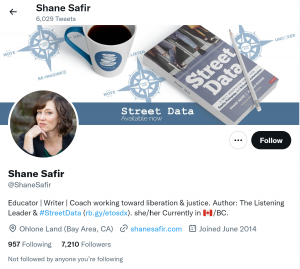
Shane Safir is an educator and writer currently based in British Columbia. She has extensive experience as coach and facilitator working in public education for over 20 years, with focus on creating spaces for educational equity. She is the co-founding principle of June Jordan School for Equity (JJSE) supporting the success of low-income students of color.
Browsing briefly through her followers and following, most of them are also educators from all levels, with majority of them K-12 teachers based in the USA and Canada.
Through this Twittering Task, I have categorized her tweets/retweets as below, as I reflect on the affordances and limitations that Twitter as a platform can provide in context of her engagement and interaction with other educators that she follows, and those who are following her.
From her original tweets, I was able to piece together some of the important concepts and ideas mentioned in her book, without having read it in its own entirety. Due to the limitation of Twitter’s word count per tweet, her lists that she’s made makes it easy to understand, but at the same time, some extra elaboration is needed to understand its relevance in context.
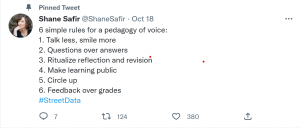
Above is one of the first tweets on her profile.
The “Pinned Tweet” indicates that this post is of high relevance and importance to her own pedagogical values as an educator, in which I assume is an important concept in her book.
The title “6 simple rules for a pedagogy of voice” is a bit unclear to me of what “voice” entails. For those who know of her work personally, or are experienced educators, this information might be apparent.
However, I am not an experienced educator myself, so I had to search it up for more context. I was able to find this article that Shane wrote, in which she goes elaborates on her “pedagogy of student voice” and how each of the points are relevant to fostering ways educators can shift classroom frameworks away from that of compliance to one that uplift students’ voices. This shift in mindset is important to create a safe, warm, and welcoming learning environment to cultivate student agency so that they can be more engaged in their own learning.

Not only does she post contents as an “educator”, she also posts content as a “parent”. This multi-faceted perspective of what she deems important from her different identities makes her values in education seem more down-to-earth and familiar, in which her pedagogy is rooted in practice and concern on a personal level as well.
Shane engages on Twitter in a personal level as illustrated above, and also actively at a community level as well. She can be seen retweeting threads and posts from others that align with her values and ideas when it comes to education. This information can be very helpful as a starting point for other educators with similar values to connect and create a broader network of those interested in reformation of school organizations, which is crucial for creating community and pushing for change in a tangible way.
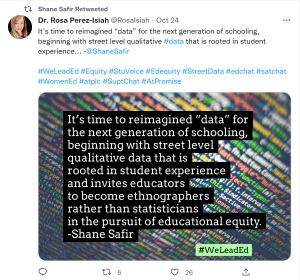
In this retweet of someone else’s post, I was able to see what other educators found impactful, and what they resonated with through Shane’s content (e.g. book, podcast, talks, interviews, etc.) or how that has affected them in return when it comes to their own pedagogical approaches.
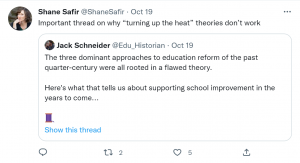
In this thread that she reposted, Shane re-affirms the importance of why “turning up the heat” theories don’t work. I followed the thread and learned that “turning up the heat” means “the racheting-up of pressure” through test-based accountability, teacher evaluations and generally creating an environment of competition.
Paired with some background knowledge of her book content, one can understand how this Twitter thread aligns with her approach to collecting street data, furthermore acting as an “endorsement” of such pedagogical practices.
Shane uses Twitter as a promotional platform for other forms of media, specifically for her podcast Street Data Pod, in which she invites speakers for discussion and interviews about various aspects surrounding education. This approach to creating conversation reflects her strong beliefs of the need and importance of collecting qualitative data from educators to inform educational practices.
In her interviews, one can also see that she invites many educators of color to talk about equity, and anti-racist practices. By centering their voices and experiences, it is clear that “practicing what she preaches” is at the core and forefront of her pedagogical values.
Twitter is not the greatest place for in-depth and nuanced back-and-forth engagement, especially when a lot of Shane’s career as a coach and facilitator is a role that promotes communication and conversation with others. I can see why she would outsource her preferred method of audio, verbal and written engagement to other platforms.
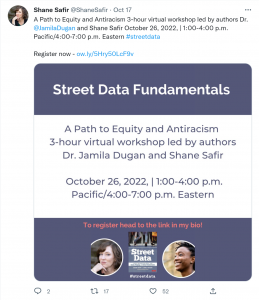
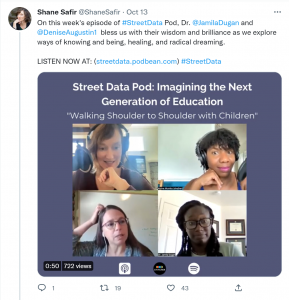
Here she is seen advertising her workshop with her co-author on Twitter with an infographic, as it is easier to catch one’s attention with an image than it is with plain text.
Curious whether she is on other platforms that prioritize images, I did a quick search and found her Instagram. She has two Instagram profiles, one where she shares her personal life through photos of family and friends; and the other for her professional life through sharing promotional infographics of her podcast and workshops.
Through her social media use patterns, it is apparent that the limitations of text on Twitter and images on Instagram makes it difficult to use them as the main platforms for engaging deeply with her writings. However, Twitter is a great place to create community (arguably more so that Instagram), and a very effective way to expand her network and spread what she does professionally.
Shane has her own personal website, acting as a portfolio and main place in which she posts all of her professional work. Her Street Data Podcast can be found on Apple Podcasts, Podbean App, and Spotify.
Our goal is to offer a digital centralized health management platform for special education students. Oftentimes, special education students have a large support network that can include a multitude of personal support workers (PSW) and individuals. For example, special education students can have school teachers, external tutors, speech therapists, physical therapists, and more depending on their needs.
Through our experiences working the public health system (Helena) and working with youths on the autism spectrum (Sophy), we realized there lacked an accessible and centralized platform for parents and PSWs to communicate and collaborate with each other.
Our platform serves to create a centralized space where all the support workers can input data, information, and clinical notes about the child’s progress for the parents and all the other PSWs to access.
MySupport seeks to make the lives of parents and families easier by removing the burden of tracking and organizing feedback and progress between PSWs. Parents, especially in blended or divorced families where guardians are not always together to support the child may benefit from centralized communication. Further, with children that require a high level of support, extended family like grandparents might also be involved. MySupport allows all relevant parties caring for the child to stay updated and aware of their development. Effectively, the platform streamlines communication across all stakeholders and removes the possibility that information will be forgotten, lost, or missed.
All personal support workers would be given access to the child’s profile and each PSW worker would have a respective section where they would be able to upload documents, add updates, and keep track of the child’s progress. Over the period in which they are supporting the child, each PSW would also have access to the other PSWs sections to be able to see their updates as well. Parents would be able to control who has access to each section, for example a parent might not feel comfortable with a tutor seeing the physical therapists updates, so the tutor would only have access to the school teachers updates. The control of visibility would be determined by the parents and the respective PSW. However, each PSW would have a dashboard where all the updates from other PSW would be centralized and organized so that they could stay in the loop with the students’ progress through written documentation.
Further, our platform would include integrated survey and questionnaire methods that allow parents and PSW to keep track of progress being made using assessment methods that could then be extrapolated to find patterns and helpful data.
The centralized platform would mean that all the information and required documents would be added to the platform by individuals. Each individual would need to have a place to store their respective materials as well as one place where all the updates could be easily displayed, preferably in a chronological order. Further, this dashboard would act as a database that allows parents and PSW to search for information if they need to reference anything.
We intend on deploying our product ona cloud-based customer relationship management (CRM) platform. The benefit of using a CRM platform in a healthcare management setting, is that it includes several automation and integration features that would make catering our product to several PSWs more inclusive. For example, being able to integrate Google Classroom schedules as well as an Outlook calendar into a centralized calendar system ensures that all important dates are automatically populated. Further, contact management and pipeline management are needed to help track and manage progress and internal development.
Salesforce would be an ideal platform, as it is expansive, versatile, and scalable depending on the team’s needs, and the cloud-based portal would make the platform accessible. However, a limitation to using this platform is that the service is not free for small business or individual users. Meaning, it is more cost effective for the development of our prototype to look elsewhere and find a product that is more financially accessible in the time being.
Similar CRM technologies include Hubspot, Zoho, Freshsales, Insightly, etc.
For the demonstration of our tool, we plan to use Hubspot as it is more user-friendly on smaller scales and has more affordable plans. In the Free CRM Plan, the automation function is limited, and requires upgrade and payment. It can also be easily integrated with other external applications for file storage, spreadsheets, emails, databases, etc.
Our main limitation is to ensure that the healthcare management system must comply with HIPPA health regulations and privacy concerns.
We were to listen to lectures on technology from 30 years ago created by Massey College at University of Toronto, and think about the “media ecology” created from these lectures, and how it functions as a form of educational technology.
Then, skimming Ursula Franklin’s text The Real World of Technology, we were to think about Franklin’s categories of “prescriptive” and “holistic” technologies as applied to educational technologies.
Lastly, a close reading of Chapter 2 of Illich and Sanders’ ABC: The Alphabetization of the Popular Mind to describe “oral technologies” and how they shape thinking, memory and communication in the context of their concept of “memory palace”.
Some additional questions to consider:
First, stick to Taylor’s specific arguments (supplemented by the Harry Potter excerpt) to identify and explain how online learning can risk reverting to The Umbridge Approach.
Then, using Taylor’s own terms, supplemented by Baynes et al. paper on being “at” UBC as a distance education student. What has been your own experience of online learning? Describe current situation in the MET program at UBC, how would one take up Taylor’s argument(s) about the “relative value” of your degree under the massification of online education?
Taylor (1996) outlines many of the pedagogical benefits and challenges of open learning, specifically under the concept of looking at borders in the context of “social resources associated with the use of educational artifacts”, especially around the focus of social conventions which are integral to such artifacts (p. 60).
One challenge was how open learning lacks social inertia which is strongly associated with authority, as the material properties that lend authority to the educational experience are stripped away by the usage of information and communication technologies (p. 68).
The physical demassification of the classroom and the social demassification of higher education in this sense means higher customizability of pedagogical practices to particular groups. However, the paradox to this would be that the social conventions and identities of “student” and “teacher” are stripped away by the adoption of open learning, which challenges authority and legitimacy of knowledge and pedagogical practices once it has moved beyond the confines of a physical institution.
Relating back to the Harry Potter excerpt per essay prompt, this can be illustrated through Prof. Umbridge’s approach to teaching the Dark Arts (Rowling, 2003).
In her class, Prof. Umbridge holds the authority and commands the classroom with her tyrannical rules. The students parrot “Yes, Prof. Umbridge” or “No, Prof. Umbridge”, which reinforces her reign and those who do not follow, or question her approach will receive negative consequences (p. 240).
Her use of the textbook “Defensive Magical Theory” also upholds the legitimacy of knowledge that is “carefully structured, theory-centered, Ministry-approved” written by “Ministry-trained educational experts” (p. 242)
This poses as a problematic reverting and overcompensation of “packaging the course into an extensive syllabus” and “strong preoccupation of what to teach rather than how to teach”. This pedagogy is limiting and leads to an overly teacher- and curriculum-centered approach that is more “closed” where both teacher and students have less space to make and influence decisions (Taylor, 1996, p. 72).
Reflecting on my current experiences in this course, I now understand what Taylor means by the “stripping away” of social conventions and social inertia in distance education, especially in the ways of interaction and collaboration with my instructor and peers.
With most of the course communication on Slack, the immediacy and ability to instantaneously contact others was a strange spatial break down in terms of the social and material interactions which take place within in. (Baynes, 2014, p. 572).
The renegotiation of professional and hierarchical boundaries renders the rapport and interaction between student and instructor rather casual and friendly. On one hand, this equalized the dimension of authority within the class, opening up the space for more student-centered co-contribution within the course. On the other hand, with the lack of facilitated discussions or peer feedback on assignments, this “inconsequential” quality of interaction permeates the learning atmosphere such that it feels quite difficult to co-create my learning experience with others, more like shouting out into the void.
I think this is an example of attempting to find equilibrium between the physical and social demassification of open education, and the renegotiation of social conventions surrounding such fluid and mobile learning environments, especially through the mediation of communication technology, reiterating the notion that “technology is neither good nor bad in itself, but it is the way that it is used that matters” (Taylor, 1996).
Bayne, S., Gallagher, M. S., & Lamb, J. (2014). Being ‘at’ university: The social topologies of distance students. Higher Education, 67(5), 569-583. doi:https://doi.org/10.1007/s10734-013-9662-4
Rowling, J. K. (2003). Chapter 12 Professor Umbridge. In Harry Potter and the Order of the Phoenix. New York
Taylor, P. G. (1996). Chapter 3: Pedagogical challenges of open learning: Looking to borderline issues. Counterpoints (New York, N.Y.), 29, 59-77.
In Lum’s introduction to media ecology (2000), he states “media ecology should be viewed as a field of study that is ever-evolving”, as can be seen in the back and forth between scholars. He attempts to position media ecology as an “intellectual tradition and a theoretical perspective”. However, to define media ecology as such is to be limited to passive perception and reception. To “wake up from our environmentally-induced stupor” (de Castell et al., 2014) we need to not just unilaterally, but reciprocally and actively engage with the environment around us. To find ourselves embodied and as embodiment, and also embedded into the environment, perhaps to an extent such that when we reach out to embrace the world, we can also feel the imprint of the “fleshiness” of the world around us.
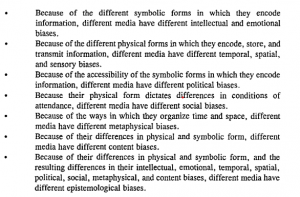
Nystrom’s generalizations of forms and their “biases” really intrigued me, though I argue “affordances” seems more fitting, as it has a more positive connotation of what it has to “offer”.
I make this distinction, as “affordances” looks for the “potential” rather than the “limitations”, and I think that is a core essential part of “media ecology”. The “potential” for media to have impact to “create the environment or symbolic and cognitive structure in which people construct the world they know and understand, as well as its social, economic, political and cultural consequences” (Lum, 2000, p.2)
To see “potential” is to harness the human agency that we have in making meaning of the world around us in the ways that we are situated in, as Geddes argues “no living organism can be understood except in the terms of the total environment in which it functioned” (Strate & Lum, 2000, p. 68).
However, the boundaries can seem quite blurry, where does an organism end and the environment begin? Just as the physical form of media is as important as the symbolic form it conveys, and that “the content of a medium is another medium” to the extent of “understanding media as environment and environment as media”, there seems to be systems within systems that are interrelated, connected, and can be two things either/or and both at once. Like “building” in the nominal sense contributing to part of the city landscape as container, provides a space or activities as an interface, and engaging with the space through social practice as a way to create meaning (de Castell et al., 2014). What is built simultaneously builds new substance that feeds into itself, and continues to be used to create new substance. The self-recursion of constant mediation between organism and environment as “selbstbildung” is what I believe allows one to feel embodied and embedded with and within the environment in which it relates to the self.
Going back to Lum’s “ever-evolving field” of media ecology, and the concepts of affordances and selbstbildung, I believe it is necessary to approach it from a production pedagogy and “attend to verbs” — by taking action to disrupt the inertia of the environment to “incite critical engagement and thought, unseating our concepts and disorienting our percepts” as McLuhan puts it (de Castell et al., 2014). Mumford argues what makes human species unique is not tools, industry or labor, rather, language, art and play. Therefore, echoing the notion of de Castell et al. (2014, p. 90), I would like to add the element of “play” as the foundation of “learning” extending to the intentional act of “designing” as the process of meaning-making.
Play disrupts the current equilibrium to question what is known, and provides momentum to give rise to creation. To create and “engage in building” in a controlled, perhaps methodological way is to learn how to “mediate interconnectively between and among agents both human and not” such that “education is a practice of building“. To build sustainably is to create a “system that produces its own future capacity”, and reiterates the “active, situated, knowledgeable and skillfully productive” act of education to create an “ecology that demands the inhabitants to learn themselves, how to maintain it” such that it reaches equilibrium until it is disrupted again and again, over and over, with its every iteration and evolution. To continue this natural recursion is to allow the world to affect and envelope us in the ways that it does, and to entwine ourselves into the curves of the landscape, to fully feel its embrace and to embrace it back with just as muchness, unequivocally.
Castell, S. d., Droumeva, M., & Jenson, J. (2014). Building as interface: Sustainable educational ecologies. Medienpädagogik, 24(24), 75-93. https://doi.org/10.21240/mpaed/24/2014.09.08.X
Lum, C. M. K. (2000). Introduction: The intellectual roots of media ecology. The New Jersey Journal of Communication, 8(1), 1-7. https://doi.org/10.1080/15456870009367375
Strate, L., & Lum, C. M. K. (2000). Lewis mumford and the ecology of technics. The New Jersey Journal of Communication, 8(1), 56-78. https://doi.org/10.1080/15456870009367379